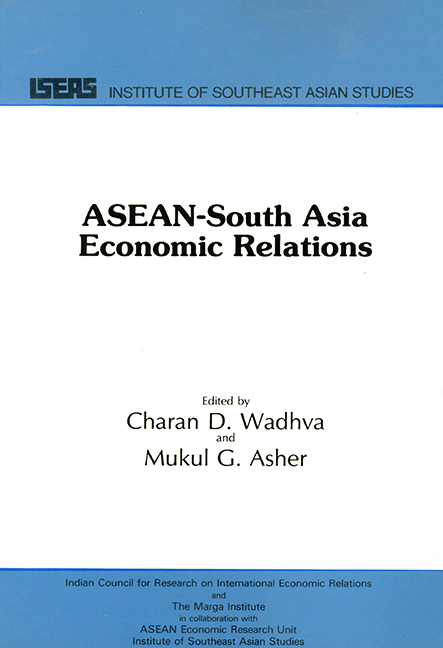Book contents
- Frontmatter
- Contents
- Foreword
- Exchange Rates of ASEAN and South Asian Countries
- An Overview
- PART ONE ASEAN COUNTRY STUDIES
- Economic Relations between Indonesia and South Asia
- Malaysia-South Asia Economic Relations: A Preliminary Study
- Philippine-South Asia Economic Relations
- Economic Relations between Singapore and South Asia
- Economic Relations between Thailand and South Asia
- PART TWO SOUTH ASIA COUNTRY STUDIES
- Postscript
- Appendix SITC Classification at One-, Two-, and Three-digit Levels
- THE EDITORS
Economic Relations between Singapore and South Asia
from PART ONE - ASEAN COUNTRY STUDIES
Published online by Cambridge University Press: 21 October 2015
- Frontmatter
- Contents
- Foreword
- Exchange Rates of ASEAN and South Asian Countries
- An Overview
- PART ONE ASEAN COUNTRY STUDIES
- Economic Relations between Indonesia and South Asia
- Malaysia-South Asia Economic Relations: A Preliminary Study
- Philippine-South Asia Economic Relations
- Economic Relations between Singapore and South Asia
- Economic Relations between Thailand and South Asia
- PART TWO SOUTH ASIA COUNTRY STUDIES
- Postscript
- Appendix SITC Classification at One-, Two-, and Three-digit Levels
- THE EDITORS
Summary
INTRODUCTION
This paper assesses the level, structure, and prospects concerning economic relations between Singapore and South Asia. While the main emphasis is on trade and investment relations, other economic relations, such as flow of tourists, presence of financial institutions, labour flows, and so forth, are also briefly discussed. For the purpose of this study, South Asia consists of Bangladesh, Bhutan, India, Nepal, Pakistan, and Sri Lanka. Singapore has, however, no economic relations with Bhutan.
The selected economic indicators of Singapore and South Asia (see Table 1) indicate the basic dissimilarities in the economies of Singapore and South Asia. Singapore's per capita GNP (gross national product) is about twenty-one times that of South Asia, while the average annual growth rate of its per capita GNP for the period 1960-81 is slightly more than two and a half times that of Pakistan, the country with the highest growth rate in South Asia. The low level of participation by South Asia in the international merchandise trade is also evident from the data in Table 1. In spite of South Asia's GDP (gross domestic product) being about seventeen times that of Singapore, the percentage of world exports and imports accounted for by Singapore is greater than that of South Asia. The importance of the agricultural sector in the South Asian economies is also evident from the data in Table 1.
In spite of the above dissimilarities, it may be pertinent to examine economic relations between Singapore and South Asia to assess their prospects. As far as Singapore is concerned, South Asia may provide an additional avenue for diversifying its sources of trade, investment, and technology. Moreover, for differing reasons, the South Asian countries, such as Bangladesh, India, and especially Sri Lanka, have adopted much more outward-looking development strategies in recent years. This is likely to increase the level of participation in international economic relations. Singapore may want to avail itself of the trade, investment, and other opportunities which may arise from such increased participation by these South Asian countries.
- Type
- Chapter
- Information
- ASEAN-South Asia Economic Relations , pp. 138 - 184Publisher: ISEAS–Yusof Ishak InstitutePrint publication year: 1985



